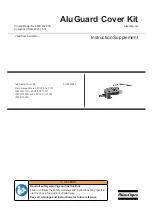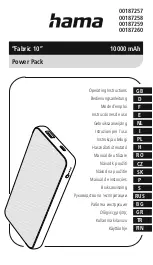
CARING FOR THE ENVIRONMENT
TROUBLESHOOTING
Power tools that are no longer usable should not be disposed of with
household waste but in an environmentally friendly way. Please recycle
where facilities exist. Check with your local council authority for
recycling advice.
Recycling packaging reduces the need for landfill and raw materials.
Reuse of recycled material decreases pollution in the environment.
Please recycle packaging where facilities exist. Check with your local
council authority for recycling advice.
Spare parts can be ordered from the Special Orders
Desk at your local Bunnings Warehouse.
For further information, or any parts not listed here,
visit www.ozito.com.au or contact Ozito Customer
Service:
Australia 1800 069 486
New Zealand 0508 069 486
E-mail: [email protected]
SPARE PARTS
• Keep air intake clean and air vents free of debris to avoid overheating the motor.
• Do not use cleaning agents to clean the plastic parts of the tool.
A mild detergent on a damp cloth is recommended. Water must never come into contact with
the tool.
• If the blower vibrates abnormally, stop motor immediately. Abnormal vibration usually indicates
a mechanical problem continued operation could lead to injury or damage.
WARNING!
ALWAYS ENSURE THE TOOL HAS
COMPLETELY STOPPED AND THE BATTERY IS
REMOVED PRIOR TO ANY MAINTENANCE.
Problem Cause
Remedy
Blower is not
starting
Battery is low in charge
Charge battery
Battery not inserted
properly
Insert battery pack correctly
Possible clogging
Clean the blower tube and blower outlet of
any leaves or debris.
Blower is not
operating at
full capacity
Possible clogging
Clean the blower tube and blower outlet of
any leaves or debris.
Motor stops
while blowing
Battery has no power
Charge battery
Note: Ozito Industries will not be responsible for any damage or injuries caused by the repair of the
blower by an unauthorised person or by mishandling of the blower. This tool is designed for DIY use
- use in commercial or industrial environments will void the warranty.
DESCRIPTION OF SYMBOLS
THIS MANUAL CONTAINS IMPORTANT SAFETY AND OPERATING INSTRUCTIONS FOR YOUR
BATTERY CHARGER.
1.
Before using the charger read all instructions and cautionary markings on the charger, battery pack and the product
using the battery pack.
2.
This charger is not intended for any uses other than charging rechargeable batteries. Any other use may result in risk
of fire, electric shock or electrocution.
3.
Do not place any object on top of the charger or place the charger on a soft surface that may result in excessive
internal heat. Place the charger in a position away from any heat source.
4.
To reduce risk of damage to the electric plug and cord, pull by the plug rather than the cord when disconnecting the
charger.
5.
Make sure the cord is located so that it will not be stepped on, tripped over, or otherwise subjected to damage or
stress.
6.
An extension cord should not be used unless absolutely necessary. Use of an improper extension cord could result in the risk
of fire, electric shock or electrocution.
7.
Do not operate the charger if it has received a sharp blow, been dropped or otherwise damaged in any way. Have it
checked by an electrician or power tool repairer.
8.
Do not disassemble charger. Take it to an electrician or power tool repairer when service or repair is required. Incorrect
reassembly may result in a risk of electric shock, electrocution or fire.
9.
To reduce risk of electric shock, unplug the charger from the outlet before attempting any cleaning. Removing the
battery pack will not reduce this risk.
10.
Never attempt to connect 2 chargers together.
11.
DO NOT store or use the tool and battery pack in locations where the temperature may reach or exceed 40ºC (such as inside
sheds or metal buildings in summer).
12.
The charger is designed to operate on standard household electrical power (240 volts). Do not attempt to use it on any
other voltage!
13.
The battery pack is not fully charged out of the carton. First read the safety instructions and then follow the charging
notes and procedures.
14.
The longest life and best performance can be obtained if the battery pack is charged when the air temperature is
between 18 - 24ºC. Do not charge the battery pack in an air temperature below 10ºC or above 40ºC. This is important
and will prevent damage to the battery pack.
15.
Do not incinerate the battery pack even if it is seriously damaged or is completely worn out. The battery can explode in
a fire.
16.
Never attempt to open the battery pack for any reason. If the plastic housing of the battery pack breaks or cracks, immedi-
ately discontinue use and do not recharge.
17.
During charging, the battery must be placed in a well ventilated area.
BATTERY AND CHARGER SAFETY WARNINGS
MAINTENANCE
Read instruction manual
Do not use in the rain or leave the blower outdoors while raining.
Keep bystanders away. Do not operate whilst people especially
children or pets are in the area.
Wear eye and ear protection.
Regulator compliance mark



































